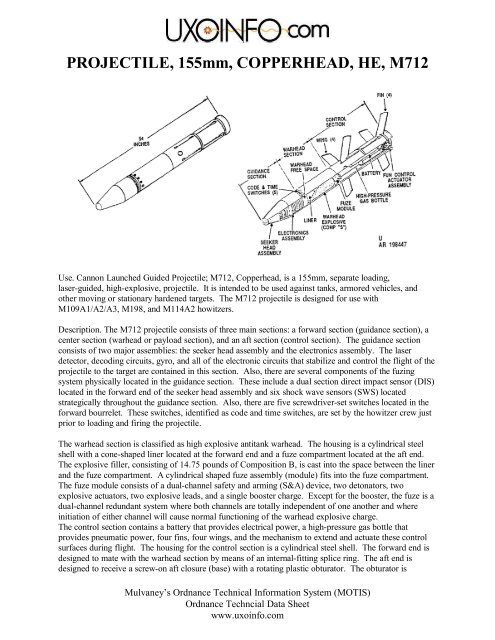PROJECTILE, 155mm, COPPERHEAD, HE, M712
PROJECTILE, 155mm, COPPERHEAD, HE, M712
PROJECTILE, 155mm, COPPERHEAD, HE, M712
- No tags were found...
Create successful ePaper yourself
Turn your PDF publications into a flip-book with our unique Google optimized e-Paper software.
<strong>PROJECTILE</strong>, <strong>155mm</strong>, <strong>COPPER<strong>HE</strong>AD</strong>, <strong>HE</strong>, <strong>M712</strong>Use. Cannon Launched Guided Projectile; <strong>M712</strong>, Copperhead, is a <strong>155mm</strong>, separate loading,laser-guided, high-explosive, projectile. It is intended to be used against tanks, armored vehicles, andother moving or stationary hardened targets. The <strong>M712</strong> projectile is designed for use withM109A1/A2/A3, M198, and M114A2 howitzers.Description. The <strong>M712</strong> projectile consists of three main sections: a forward section (guidance section), acenter section (warhead or payload section), and an aft section (control section). The guidance sectionconsists of two major assemblies: the seeker head assembly and the electronics assembly. The laserdetector, decoding circuits, gyro, and all of the electronic circuits that stabilize and control the flight of theprojectile to the target are contained in this section. Also, there are several components of the fuzingsystem physically located in the guidance section. These include a dual section direct impact sensor (DIS)located in the forward end of the seeker head assembly and six shock wave sensors (SWS) locatedstrategically throughout the guidance section. Also, there are five screwdriver-set switches located in theforward bourrelet. These switches, identified as code and time switches, are set by the howitzer crew justprior to loading and firing the projectile.The warhead section is classified as high explosive antitank warhead. The housing is a cylindrical steelshell with a cone-shaped liner located at the forward end and a fuze compartment located at the aft end.The explosive filler, consisting of 14.75 pounds of Composition B, is cast into the space between the linerand the fuze compartment. A cylindrical shaped fuze assembly (module) fits into the fuze compartment.The fuze module consists of a dual-channel safety and arming (S&A) device, two detonators, twoexplosive actuators, two explosive leads, and a single booster charge. Except for the booster, the fuze is adual-channel redundant system where both channels are totally independent of one another and whereinitiation of either channel will cause normal functioning of the warhead explosive charge.The control section contains a battery that provides electrical power, a high-pressure gas bottle thatprovides pneumatic power, four fins, four wings, and the mechanism to extend and actuate these controlsurfaces during flight. The housing for the control section is a cylindrical steel shell. The forward end isdesigned to mate with the warhead section by means of an internal-fitting splice ring. The aft end isdesigned to receive a screw-on aft closure (base) with a rotating plastic obturator. The obturator isMulvaney’s Ordnance Technical Information System (MOTIS)Ordnance Techncial Data Sheetwww.uxoinfo.com
etained between the aft closure and the control section housing. It is designed to not only seal offpropelling charge gases but the rotating feature of the obturator reduces the spin of the projectile toapproximately 10 revolutions per second. This spin rate is sufficient to deploy the fins, but slow enoughto allow the control surfaces to stabilize the projectile through the entire flight. The base of the <strong>M712</strong>projectile is designed to receive an extractor device used to unload the projectile from the gun tube.Functioning. The <strong>M712</strong> projectile is designed for indirect firing operations only. However, the projectiletrajectory can be programmed for either the ballistic mode or (high trajectory) or the glide mode (generallyflatter). When the round is fired, the setback and acceleration forces initiate the mechanical arming portionof the fuze S&A. These forces also cause the fins to unlatch and a portion of the battery to activate. Onleaving the tube, the fins snap out by centrifugal force, and lock in the extended position. After the timedelay set in by the code and time switches has expired, the main portion of the battery will activate,providing electrical power to all of the electronic circuits in the projectile. At the approximate midpoint ofthe trajectory, the wings will be deployed and the roll control and guidance functions will take over theflight of the projectile. When the projectile receives and decodes the laser energy reflected from thetarget, the projectile will steer onto a gliding intercept course to the target. At the same time, the fuze willbecome electrically armed. When the projectile hits the target, either the direct impact sensors or theshock wave sensors will trigger the fuze detonators and the warhead will function.WeightLengthExplosive FillPropelling ChargePrimerColor138 pounds54 inchesComp B, 14.75 poundsM3A1, M4A2, M119, A1 & A2M82Black with Yellow MarkingsReference: TM 43-0001-28, Army Ammunition Data Sheets, Artillery Ammunition, April 1994Mulvaney’s Ordnance Technical Information System (MOTIS)Ordnance Techncial Data Sheetwww.uxoinfo.com
















